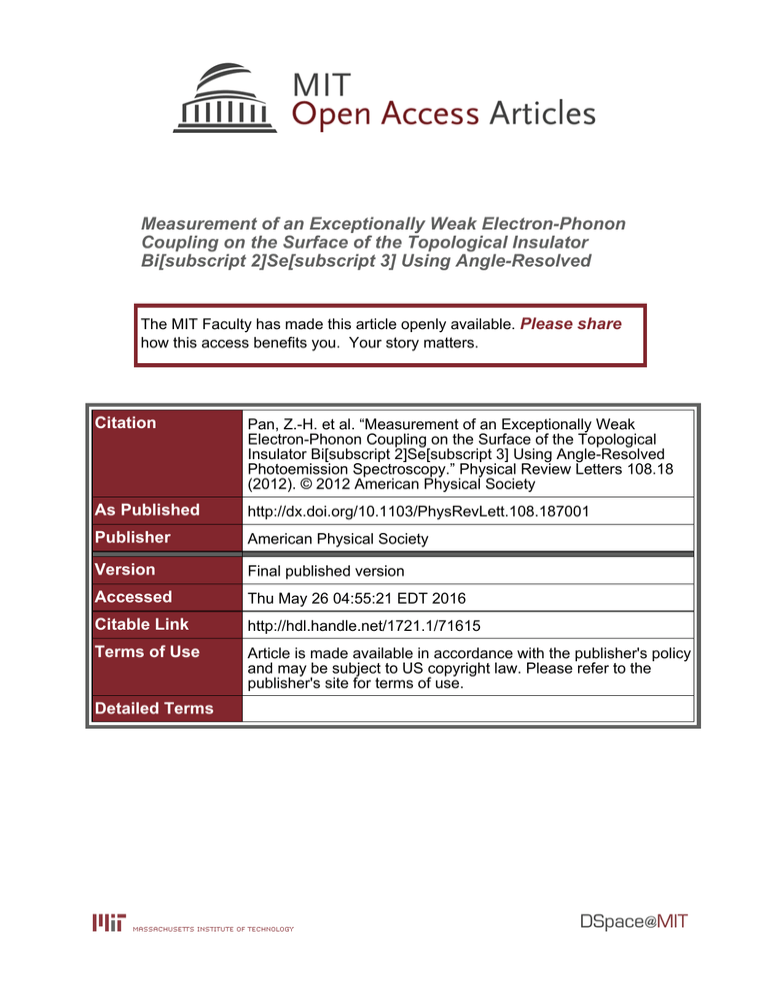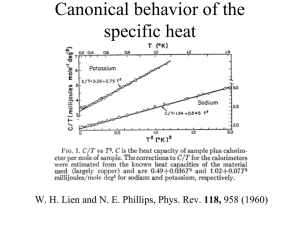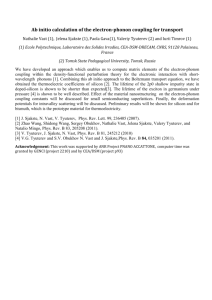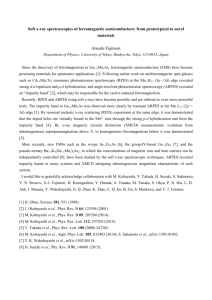Measurement of an Exceptionally Weak Electron-Phonon
advertisement

Measurement of an Exceptionally Weak Electron-Phonon Coupling on the Surface of the Topological Insulator Bi[subscript 2]Se[subscript 3] Using Angle-Resolved The MIT Faculty has made this article openly available. Please share how this access benefits you. Your story matters. Citation Pan, Z.-H. et al. “Measurement of an Exceptionally Weak Electron-Phonon Coupling on the Surface of the Topological Insulator Bi[subscript 2]Se[subscript 3] Using Angle-Resolved Photoemission Spectroscopy.” Physical Review Letters 108.18 (2012). © 2012 American Physical Society As Published http://dx.doi.org/10.1103/PhysRevLett.108.187001 Publisher American Physical Society Version Final published version Accessed Thu May 26 04:55:21 EDT 2016 Citable Link http://hdl.handle.net/1721.1/71615 Terms of Use Article is made available in accordance with the publisher's policy and may be subject to US copyright law. Please refer to the publisher's site for terms of use. Detailed Terms PRL 108, 187001 (2012) week ending 4 MAY 2012 PHYSICAL REVIEW LETTERS Measurement of an Exceptionally Weak Electron-Phonon Coupling on the Surface of the Topological Insulator Bi2 Se3 Using Angle-Resolved Photoemission Spectroscopy Z.-H. Pan,1 A. V. Fedorov,2 D. Gardner,3 Y. S. Lee,3 S. Chu,4 and T. Valla1,* 1 Condensed Matter Physics and Materials Science Department, Brookhaven National Laboratory, Upton, New York 11973, USA 2 Advanced Light Source, Lawrence Berkeley National Laboratory, Berkeley, California 94720, USA 3 Department of Physics, Massachusetts Institute of Technology, Cambridge, Massachusetts 02139, USA 4 Center for Materials Science and Engineering, Massachusetts Institute of Technology, Cambridge, Massachusetts 02139, USA (Received 20 May 2011; published 3 May 2012) Gapless surface states on topological insulators are protected from elastic scattering on nonmagnetic impurities which makes them promising candidates for low-power electronic applications. However, for widespread applications, these states should have to remain coherent at ambient temperatures. Here, we studied temperature dependence of the electronic structure and the scattering rates on the surface of a model topological insulator, Bi2 Se3 , by high-resolution angle-resolved photoemission spectroscopy. We found an extremely weak broadening of the topological surface state with temperature and no anomalies in the state’s dispersion, indicating exceptionally weak electron-phonon coupling. Our results demonstrate that the topological surface state is protected not only from elastic scattering on impurities, but also from scattering on low-energy phonons, suggesting that topological insulators could serve as a basis for roomtemperature electronic devices. DOI: 10.1103/PhysRevLett.108.187001 PACS numbers: 74.25.Kc, 71.18.+y, 74.10.+v, 79.60.i Three-dimensional topological insulators (TIs) have Dirac-like surface states in which the spin of the electron is locked perpendicular to its momentum in a chiral spinstructure where electrons with opposite momenta have opposite spins [1–8]. A direct consequence of the chiral spin structure is that a backscattering, which would require a spin-flip process, is not allowed if a time- reversalinvariant perturbation, such as nonmagnetic disorder, is present [1], making these surface states promising candidates for spintronics and quantum computing applications, where the spin coherence is crucial. [9–15]. Recent scanning tunneling microscopy experiments [16–20] have shown that backscattering is indeed strongly suppressed or completely absent, despite strong atomic scale disorder. Our own angle-resolved photoemission spectroscopy (ARPES) studies have indicated that the state is remarkably insensitive to both nonmagnetic and magnetic impurities in the low doping regime, where the Fermi surface is nearly circular. The scattering is found to increases as the Fermi surface becomes hexagonally warped with increased doping, irrespective of the impurity’s magnetic moment [21]. While the elastic scattering imposes the ultimate limit on the charge transport, the inelastic scattering processes dictate material’s transport properties at finite temperatures. In particular, interactions of electrons with lattice modes is responsible for increasing resistivity with temperature in metals. The same interaction may also lead to ground states with broken symmetries, such as superconductivity or charge-density-wave states. So far, inelastic scattering processes at surfaces of TIs have been scarcely studied, with only one theoretical study on the coupling of the topological surface states (TSS) to phonons [22]. As the lattice 0031-9007=12=108(18)=187001(5) modes in general do not represent a time-reversal symmetry breaking perturbation, it might be expected that the TSS should not couple to the q 2kF phonons. Therefore, scattering on phonons should resemble scattering on nonmagnetic impurities, where the rates are shown to be sensitive to the Fermi surface size and shape [21]. On the other hand, the proximity of bulk states, which in some cases could be strongly coupled to phonons (occurrence of superconductivity upon Cu-doping in Bi2 Se3 and under pressure in Bi2 Te3 [23–25]), could also influence the TSS by allowing the interband electron-phonon scattering. As these processes will play a crucial role in determining performances of any real devices based on TIs, their better understanding is an imperative. In this Letter, we present the high-resolution ARPES studies of the scattering rates on the surface of a TI, Bi2 Se3 . We observe a very weak temperature broadening of the TSS and no anomaly in the state’s dispersion due its coupling to phonons. Our results show that the electronphonon coupling is suppressed in a similar way as the elastic scattering, suggesting that TIs could serve as a basis for room-temperature applications. The experiments were carried out on a Scienta SES-100 electron spectrometer at the beam line 12.0.1 of the Advanced Light Source and on a Scienta 2002 analyzer at the beam line U13UB of the National Synchrotron Light Source. The spectra were recorded at the photon energy of 50 and 18.7 eV, with the combined instrumental energy resolution of 12 and 8 meV, at the Advanced Light Source and National Synchrotron Light Source, respectively. The angular resolution was better than 0:07 in both instruments. The single crystals of Bi2 Se3 were 187001-1 Ó 2012 American Physical Society PRL 108, 187001 (2012) week ending 4 MAY 2012 PHYSICAL REVIEW LETTERS synthesized by mixing stoichiometric amounts of bismuth and selenium with trace amounts of arsenic in evacuated quartz tubes [26]. Samples were cleaved at low temperature (15–20 K) under ultrahigh vacuum conditions (2 109 Pa). The temperature was measured using a silicon sensor mounted near the sample. Figure 1 illustrates the effects of raising temperature on the electronic structure of Bi2 Se3 measured in ARPES around the center of the surface Brillouin zone. The rapidly dispersing conical state in Figs. 1(b) and 1(c) represents the TSS that forms a circular Fermi surface shown in Fig. 1(a). Its filling varies with temperature as evident from the shift of the Dirac point from 0:27 eV below the Fermi level at 18 K to 0:23 eV at 255 K. This temperature induced shift and the corresponding change in the Fermi surface area are fully reversible upon temperature cycling as can be seen in panels (d)–(f). We note that at the pressure of 2 109 Pa, TSS is very stable if kept at constant temperature, without noticeable changes in the spectra several hours after cleaving. Therefore, the effects shown in Fig. 1 reflect the intrinsic temperature induced changes in the quasiparticle dynamics rather than some spurious effects caused by adsorption or desorption of residual gases. We note that similar shifts in binding energy of the state with temperature were observed in Shockley-type surface states on noble metals. These shifts could be explained in the simple phase accumulation model where the phase change on the crystal side of the potential well, that determines the energy of the surface state, is affected by slight changes in the bulk band gap as temperature is varied [27]. In the case of Bi2 Se3 , the bulk valence band (BVB) is expected to have the dominating effect on the energy of the Dirac point. The upward shift of the Dirac point, would indicate that the BVB also shifts up and that the bulk band gap in Bi2 Se3 decreases with increasing temperature. To quantify the changes in the spectral width of TSS, we have analyzed the photoemission spectra at different temperatures using the standard method where the momentum distribution curves (MDCs) are fitted with Lorentzian peaks [28,29]. The width of the Lorentzian peak, kð!Þ, is related to the quasiparticle scattering rate ð!Þ ¼ 2jImð!Þj ¼ kð!Þv0 ð!Þ, where v0 ð!Þ is the bare group velocity and Imð!Þ is the imaginary part of the complex self-energy. Figure 2 shows several MDCs corresponding to the spectrum from Fig. 1(b) and summarizes the results of the analysis. The spectral region above the Dirac point is very clean: it consists of two Lorentzian-shaped peaks with essentially no background intensity, the fact that makes the fitting procedure very accurate. The bulk conduction band is absent as at the chosen photon energy of 50 eV, that corresponds approximately to the Z point in the bulk Brillouin zone, it lays above the Fermi level. In contrast, the spectral region below the Dirac point is always affected by the BVB. The fitting results for the region above the Dirac point are shown in panel (b). Im displays a weaker energy dependence than k, reflecting an increasing group velocity as the state approaches the Fermi level. However, the most important observation here is that Im near the Fermi level shows very little change between 18 and 255 K. Temperature broadening of a quasiparticle peak usually reflects an increase in the scattering on phonons and its near absence here points to a very weak coupling of TSS to phonons in Bi2 Se3 . The electron-phonon coupling constant, , can be determined from the temperature slope of Imð0Þ because at higher temperatures, approximately kB T > 0 =3, the electron-phonon self-energy jImð!; TÞj ¼ FIG. 1 (color online). Temperature effects on the ARPES spectra from Bi2 Se3 . (a) Fermi surface of Bi2 Se3 at 18 K. (b) ARPES intensity along the K line in the surface Brillouin zone at 18 K and (c) at 255 K. Photoemission intensity at the Fermi level (d) and at E ¼ 270 meV (e) along the K momentum line as a function of temperature. (f) Photoemission intensity at the point as a function of temperature. Sample was heated from 18 to 255 K and then cooled back to 18 K. Z1 0 d2 FðÞ½2nðÞ þ fð þ !Þ þ fð !Þ; (1) is approximately linear in temperature, Imð0; TÞ kB T. Here 2 Fð!Þ is the Eliashberg coupling function, fð!Þ and nð!Þ are the Fermi and Bose-Einstein functions, 0 is energy of the highest involved phonon, and kB is Boltzmann’s constant [30]. In panel (c), we plot Im 187001-2 PRL 108, 187001 (2012) PHYSICAL REVIEW LETTERS week ending 4 MAY 2012 FIG. 2 (color online). Temperature broadening of TSS on Bi2 Se3 . (a) MDCs corresponding to the spectrum shown in Fig. 1(b), spaced by 50 meV, with the top curve representing the Fermi level. (b) Momentum width k (bottom) and Im (top) of the Lorentzianshaped MDC peaks at several different temperatures. Standard deviations from the fitting are within 5% of the obtained value (not shown) (c) Temperature dependence of Imð0Þ for three different samples (bottom), ED (middle), and doping level of TSS for sample A (top). Solid lines are the linear fits of Imð0Þ. averaged over 20 meV < ! < 0 as a function of temperature for three different samples. The error bars represent the standard deviation of the averaged value. Samples A and C were measured at 50 eV, while sample B was measured at 18.7 eV photon energy. Differences in the TSS’s width are partially due to the different momentum resolution at these two photon energies and partially due to the natural variation in the surface ‘‘quality.’’ However, in all three samples Im increases with temperature at a similar rate. The increase starts at low temperatures, indicating the involvement of low-energy phonons. The linear fits give ¼ 0:076 0:007 for sample A and 0:088 0:009 for sample B. This represents one of the weakest coupling constants ever reported in any material, weaker than the theoretical value from Ref. [22], but in agreement with the apparent absence of temperature broadening of TSS in recent experiments on several topological materials [31]. In contrast, the occurrence of superconductivity upon Cu-doping in Bi2 Se3 and under pressure in Bi2 Te3 [23–25] suggests much stronger coupling in the bulk of these materials. The estimate for the bulk coupling constant can be made by using the known values for Debye temperatures [32] and superconducting transition temperatures (Tc ) [23–25] in McMillan’s formula for Tc [33]: ¼ 0:62 (0.6) is obtained for Cux Bi2 Se3 (Bi2 Te3 ), almost an order of magnitude stronger than our result for the surface state. Another indication of the exceptionally weak electronphonon coupling at the surface is the apparent absence of a mass enhancement in the dispersion of TSS near the Fermi level. In Fig. 3 we show the low-energy region of the ARPES spectrum from Fig. 1(b). A hallmark of the quasiparticle coupling to phonons in the form of a sudden change in the slope or a ‘‘kink’’ in dispersion inside the phonon-energy range [29] is conspicuously missing. The MDC derived dispersion in Fig. 3 is essentially a straight line with no anomalies in the vicinity of the Fermi level, in agreement with previous studies [31]. We note that the temperature dependence from Fig. 2(c) requires the involvement of low-energy modes which, in addition to the very weak coupling, makes the observation of an anomaly in dispersion extremely difficult and it would require a much better experimental resolution. We also note that the finite experimental resolution probably already affects the extracted values of Im at low temperatures and that obtained from temperature dependence might be slightly underestimated. Our results should have very important consequences on the macroscopic properties of the Bi2 Se3 surface, in particular, on the surface state’s contribution to transport—a FIG. 3 (color online). Zoom in the low-energy region of the ARPES spectrum from Bi2 Se3 from Fig. 1(b). Dispersion of TSS (solid line) is obtained from positions of Lorentzian-fitted peaks in MDCs. 187001-3 PRL 108, 187001 (2012) PHYSICAL REVIEW LETTERS week ending 4 MAY 2012 is well protected from scattering on low-energy phonons. This keeps the possibility that TSSs could serve as a basis for room-temperature devices open. The work at Brookhaven is supported by the U.S. Department of Energy (DOE) under Contract No. DEAC02- 98CH10886. The work at MIT is supported by the DOE under Grant No. DE-FG02-04ER46134. ALS is operated by the U.S. DOE under Contract No. DE-AC0376SF00098. FIG. 4. Quasiparticle mean free path ‘ (bottom) and qp (top) as functions of temperature, determined from the ARPES spectra for samples A and B from Fig. 2(c). Gray regions represent the limits of these quantities in doped surfaces [21]. crucial aspect for any (spin) electronic device based on TSS. The surface contribution to transport has proven elusive due to the overwhelming bulk component to conductivity and/or low surface state mobility in the environment of a typical transport measurement [34–38]. The determining factor for transport is the surface state mobility, which can be expressed as S ¼ e‘tr =ð@kF Þ for the Dirac-like carriers. Here, ‘tr , represents the transport mean free path. In ARPES experiments, kF and the quasiparticle mean free path ‘ ¼ ðkÞ1 can be directly measured. In Fig. 4, we plot the quasiparticle mean free path and the quantity qp ¼ e‘=ð@kF Þ, which may serve as a lower bound for surface state mobility, as functions of temperature for samples A and B. We note that ‘tr might be significantly longer than ‘, because currents in general are not sensitive to the small angle scattering events that may dominate ‘. This discrepancy might be especially enhanced in systems in which the backscattering is suppressed, as in the case of TSSs, and we might expect significantly higher mobilities than qp shown in Fig. 4. Therefore, the unperturbed and strongly coherent TSSs, as those measured here, have a strong potential to serve as a basis for room-temperature spintronic devices. However, the environmental exposure will inevitably affect the coherence of the topological state and degrade its mobility, in a similar way as it was demonstrated in Ref. [21]. We note that recent transport experiments have detected quantum oscillations related to the TSS, yielding surface mobilities of around 104 cm2 V1 s1 on the surface of Bi2 Te3 [37], still low compared to those measured in suspended graphene or in the best semiconductors [39,40]. We suggest that controlled (ultrahigh vacuum) environment and/or an inert capping of the surface would further improve the mobilities of TSS and that such measures might be necessary for optimal functioning of TI-based devices. In summary, we have observed a weak electron-phonon coupling on the surface of Bi2 Se3 demonstrating that TSS *valla@bnl.gov [1] L. Fu, C. L. Kane, and E. J. Mele, Phys. Rev. Lett. 98, 106803 (2007). [2] H. J. Noh, H. Koh, S. J. Oh, J. H. Park, H. D. Kim, J. D. Rameau, T. Valla, T. E. Kidd, P. D. Johnson, Y. Hu et al., Europhys. Lett. 81, 57006 (2008). [3] D. Hsieh, D. Qian, L. Wray, Y. Xia, Y. S. Hor, R. J. Cava, and M. Z. Hasan, Nature (London) 452, 970 (2008). [4] H. J. Zhang, C. X. Liu, X. L. Qi, X. Dai, Z. Fang, and S. C. Zhang, Nature Phys. 5, 438 (2009). [5] D. Hsieh, Y. Xia, D. Qian, L. Wray, J. H. Dil, F. Meier, J. Osterwalder, L. Patthey, J. G. Checkelsky, N. P. Ong et al., Nature (London) 460, 1101 (2009). [6] Y. Xia, D. Qian, D. Hsieh, L. Wray, A. Pal, H. Lin, A. Bansil, D. Grauer, Y. S. Hor, R. J. Cava et al., Nature Phys. 5, 398 (2009). [7] Y. L. Chen, J. G. Analytis, J. H. Chu, Z. K. Liu, S. K. Mo, X. L. Qi, H. J. Zhang, D. H. Lu, X. Dai, Z. Fang et al., Science 325, 178 (2009). [8] Z.-H. Pan, E. Vescovo, A. V. Fedorov, D. Gardner, Y. S. Lee, S. Chu, G. D. Gu, and T. Valla, Phys. Rev. Lett. 106, 257004 (2011). [9] R. R. Biswas and A. V. Balatsky, Phys. Rev. B 81, 233405 (2010). [10] L. Fu, Phys. Rev. Lett. 103, 266801 (2009). [11] H.-M. Guo and M. Franz, Phys. Rev. B 81, 041102 (2010). [12] Q. Liu, C.-X. Liu, C. Xu, X.-L. Qi, and S.-C. Zhang, Phys. Rev. Lett. 102, 156603 (2009). [13] X. Zhou, C. Fang, W.-F. Tsai, and J. P. Hu, Phys. Rev. B 80, 245317 (2009). [14] Y. L. Chen, J. H. Chu, J. G. Analytis, Z. K. Liu, K. Igarashi, H. H. Kuo, X. L. Qi, S. K. Mo, R. G. Moore, D. H. Lu et al., Science 329, 659 (2010). [15] L. A. Wray, S. Y. Xu, Y. Xia, D. Hsieh, A. V. Fedorov, Y. S. Hor, R. J. Cava, A. Bansil, H. Lin, and M. Z. Hasan, Nature Phys. 7, 32 (2010). [16] P. Roushan, J. Seo, C. V. Parker, Y. S. Hor, D. Hsieh, D. Qian, A. Richardella, M. Z. Hasan, R. J. Cava, and A. Yazdani, Nature (London) 460, 1106 (2009). [17] T. Zhang, P. Cheng, X. Chen, J. F. Jia, X. C. Ma, K. He, L. L. Wang, H. J. Zhang, X. Dai, Z. Fang et al., Phys. Rev. Lett. 103, 266803 (2009). [18] Z. Alpichshev, J. G. Analytis, J.-H. Chu, I. R. Fisher, Y. L. Chen, Z. X. Shen, A. Fang, and A. Kapitulnik, Phys. Rev. Lett. 104, 016401 (2010). [19] J. Seo, P. Roushan, H. Beidenkopf, Y. S. Hor, R. J. Cava, and A. Yazdani, Nature (London) 466, 343 (2010). 187001-4 PRL 108, 187001 (2012) PHYSICAL REVIEW LETTERS [20] T. Hanaguri, K. Igarashi, M. Kawamura, H. Takagi, and T. Sasagawa, Phys. Rev. B 82, 081305 (2010). [21] T. Valla, Z. H. Pan, D. Gardner, Y. S. Lee, and S. Chu, Phys. Rev. Lett. 108, 117601 (2012). [22] S. Giraud and R. Egger, Phys. Rev. B 83, 245322 (2011). [23] Y. S. Hor, A. J. Williams, J. G. Checkelsky, P. Roushan, J. Seo, Q. Xu, H. W. Zandbergen, A. Yazdani, N. P. Ong, and R. J. Cava, Phys. Rev. Lett. 104, 057001 (2010). [24] J. L. Zhang, S. J. Zhang, H. M. Weng, W. Zhang, L. X. Yang, Q. Q. Liu, S. M. Feng, X. C. Wang, R. C. Yu, L. Z. Cao et al., Proc. Natl. Acad. Sci. U.S.A. 108, 24 (2010). [25] M. Kriener, K. Segawa, Z. Ren, S. Sasaki, and Y. Ando, Phys. Rev. Lett. 106, 127004 (2011). [26] H. Steinberg, D. R. Gardner, S. L. Young, and P. JarilloHerrero, Nano Lett. 10, 5032 (2010). [27] R. Paniago, R. Matzdorf, G. Meister, and A. Goldmann, Surf. Sci. 336, 113 (1995). [28] T. Valla, A. V. Fedorov, P. D. Johnson, B. O. Wells, S. L. Hulbert, Q. Li, G. D. Gu, and N. Koshizuka, Science 285, 2110 (1999). [29] T. Valla, A. V. Fedorov, P. D. Johnson, and S. L. Hulbert, Phys. Rev. Lett. 83, 2085 (1999). [30] G. Grimvall, The Electron-Phonon Interaction in Metals (North- Holland, New York, 1981). week ending 4 MAY 2012 [31] S. R. Park, W. S. Jung, G. R. Han, Y. K. Kim, C. Kim, D. J. Song, Y. Y. Koh, S. Kimura, K. D. Lee, N. Hur et al., New J. Phys. 13, 013008 (2011). [32] G. Shoemake, J. Rayne, and R. Ure, Phys. Rev. 185, 1046 (1969). [33] W. McMillan, Phys. Rev. 167, 331 (1968). [34] N. P. Butch, K. Kirshenbaum, P. Syers, A. B. Sushkov, G. S. Jenkins, H. D. Drew, and J. Paglione, Phys. Rev. B 81, 241301 (2010). [35] J. G. Analytis, J. H. Chu, Y. L. Chen, F. Corredor, R. D. McDonald, Z. X. Shen, and I. R. Fisher, Phys. Rev. B 81, 205407 (2010). [36] J. G. Analytis, R. D. McDonald, S. C. Riggs, J. H. Chu, G. S. Boebinger, and I. R. Fisher, Nature Phys. 6, 960 (2010). [37] D. X. Qu, Y. S. Hor, J. Xiong, R. J. Cava, and N. P. Ong, Science 329, 821 (2010). [38] K. Eto, Z. Ren, A. A. Taskin, K. Segawa, and Y. Ando, Phys. Rev. B 81, 195309 (2010). [39] J. J. Harris, C. T. Foxon, K. W. J. Barnham, D. E. Lacklison, J. Hewett, and C. White, J. Appl. Phys. 61, 1219 (1987). [40] K. Bolotin, K. Sikes, Z. Jiang, M. Klima, G. Fudenberg, J. Hone, P. Kim, and H. Stormer, Solid State Commun. 146, 351 (2008). 187001-5


